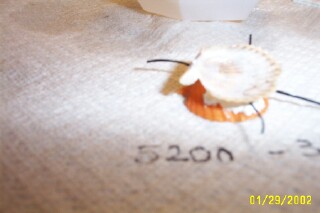Shown are 3M Co. one-part Marine Adhesives
Marine Sealant 5200 and Fast Cure 5200, Fast Cure 4200, and
Sealant 101; also shown is PSI-326, a two-part epoxy manufactured
by Polymeric Systems.

Shown
are two scallop shells with a piece of netting sandwiched
between them with 3M Co. adhesive 5200.
Samples
were prepared in a similar way to the procedure described
in the Martha's Vineyard Shellfish Project report. The pieces
of netting and the scallop shells were soaked in seawater
and then blotted dry with a paper towel. The adhesive was
applied to the shells and the netting was sandwiched between
the shells. The sandwich was left on the bench top for about
15 minutes in air. The sandwich was then immersed in a tray
of seawater, and the covered tray was stored in a refrigerator
at 34 degrees F.
The
adhesive bonds will be inspected in about a week.
Inspection
report of refrigerated samples after 3 days (on Feb. 1, 2002)
PSI-326
formed an excellent bond to both the scallop shells and the
netting after 3 days immersed in refrigerated seawater.
3M
Co. Marine Sealant 5200 formed an excellent bond to both the
shells and the netting.
3M
Co. sealant 101 was still pliable. Pretty good adhesion, but
the bond can be pulled apart and peeled off the shell surface.
3M
Co. FastCure 4200 formed an excellent bond to shells and netting.
3M
Co. FastCure 5200 was still pliable. It formed a pretty good
bond, but the adhesive can be peeled off the shell. 
